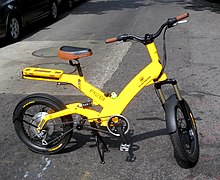Ebiking Health Benefits!
E-bikes can be a useful part of cardiac rehabilitation programmes, since health professionals will often recommend a stationary bike be used in the early stages of these. Exercise-based cardiac rehabilitation programmes can reduce deaths in people with coronary heart disease by around 27%;[56]and a patient may feel safer progressing from stationary bikes to e-bikes.[57] They require less cardiac exertion for those who have experienced heart problems.[58]
E-bikes can also provide a source of exercise for individuals who have trouble exercising for an extended time (due to injury or excessive weight, for example) as the bike can allow the rider to take short breaks from pedaling and also provide confidence to the rider that they'll be able to complete the selected path without becoming too fatigued.[59]
Some individuals have lost considerable amounts of weight by using an electric bike.[60] By making the biking terrain less of an issue, people who wouldn't otherwise consider biking can use the electric assistance when needed and otherwise pedal as they are able.[61] This means people of lower fitness levels or who haven't cycled in many years can start enjoying the many health benefits E-bikes have to offer. [1
Electric bicycle



An electric bicycle, also known as an e-bike, powerbike or booster bike, is a bicycle with an integrated electric motor which can be used for propulsion. There are a great variety of e-bikes available worldwide, from e-bikes that only have a small motor to assist the rider's pedal-power (i.e., pedelecs) to somewhat more powerful e-bikes which tend closer to moped-style functionality: all, however, retain the ability to be pedalled by the rider and are therefore not electric motorcycles. E-bikes use rechargeable batteries and the lighter varieties can travel up to 25 to 32 km/h (16 to 20 mph), depending on the laws of the country in which they are sold, while the more high-powered varieties can often do in excess of 45 km/h (28 mph). In some markets, such as Germany, they are gaining in popularity and taking some market share away from conventional bicycles,[1] while in others, such as China, they are replacing fossil fuel-powered mopeds and small motorcycles.[2][3]
Depending on local laws, many e-bikes (e.g., pedelecs) are legally classified as bicycles rather than mopeds or motorcycles, so they are not subject to the more stringent laws regarding their certification and operation, unlike the more powerful two-wheelers which are often classed as electric motorcycles. E-bikes can also be defined separately and treated as a specific vehicle type in many areas of legal jurisdiction.
E-bikes are the electric motor-powered versions of motorized bicycles, which have been around since the late 19th century. Some bicycle-sharing systems use them.[4]
Recent Posts
-
The Significance of Maintaining a Healthy Diet!
The Impact of Nutrition on Your HealthUnhealthy eating habits have contributed to the obesity epidem …Apr 15th 2024 -
Enhance Weight Loss and Overcome Your Plateau with these 5 Easy Tips
If you need to lose a few extra pounds but feel you've hit a plateau, there are several ways to get …Apr 15th 2024 -
The Importance of Excercise!
What are the health benefits of exercise?Regular exercise and physical activity may Help you contro …Apr 15th 2024
















